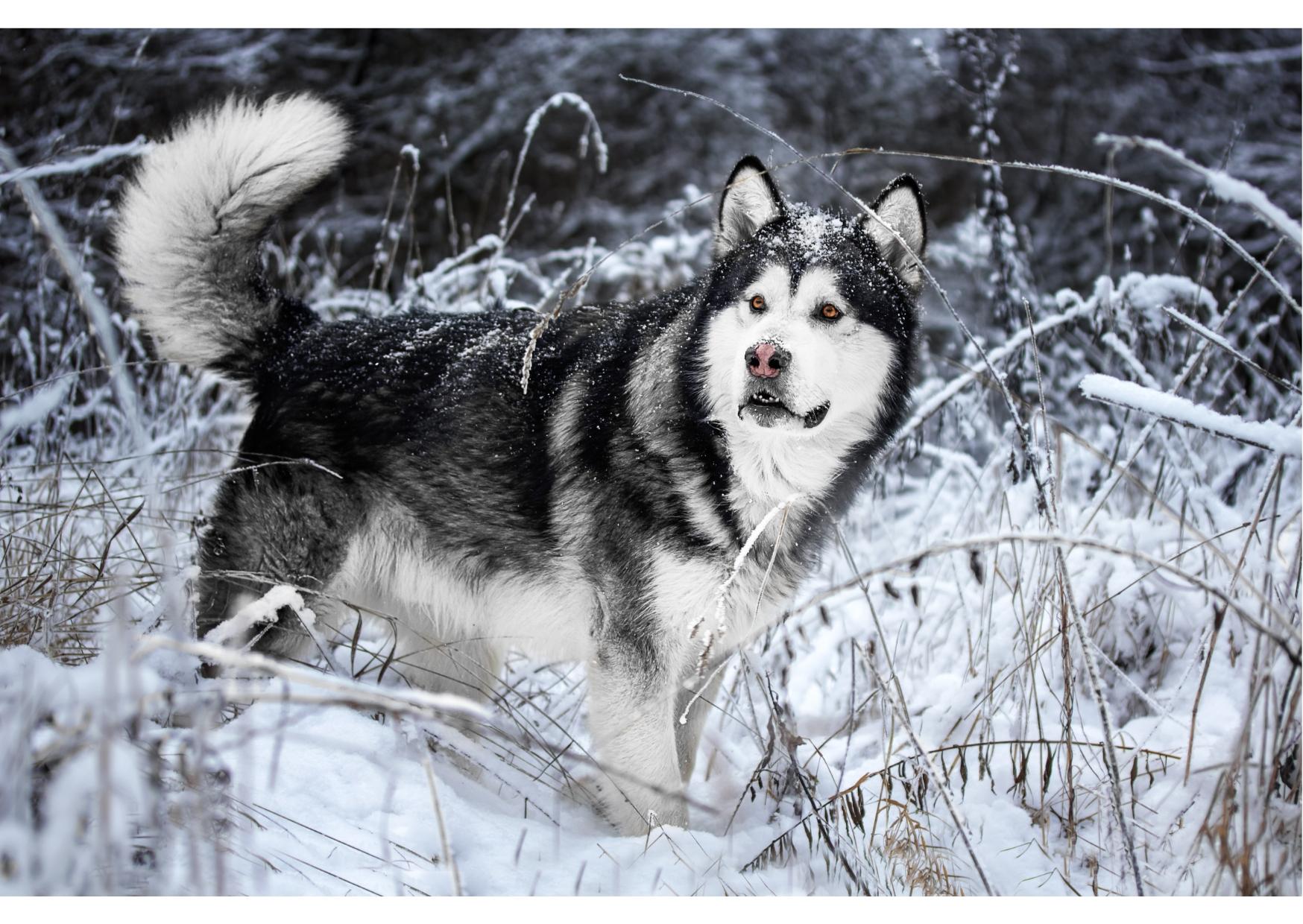ALASKAN MALAMUTE
| Group: | Working |
|---|---|
| Size: | Large |
| Temperament: | Loyal, Affectionate and Fun |
| Height: | 24-26 inches (male), 22-25 inches (female) |
| Weight: | 36-40 Kg (male), 32-37 Kg (female) |
| Life Expectancy: | 11-15 years |
| Origin: | US |
| Coat Length: | Medium |
| Coat Type: | Double |
| Color: | Agouti & White Black & White Blue & White Gray & White Red & White Sable & White Seal & White Silver & White White |
About
The Alaskan Malamute is a powerful, heavy-duty worker of the spitz breed that is friendly, devoted, playful, and dignified. He can be identified by his well-furred, plumed tail draped over the back, erect ears, and hefty bone. A huge, sled-pulling dog that is good at blending into a family. In addition to having exceptional stamina, strength, and perseverance, this breed, which is commonly used on polar expeditions, also has highly developed senses of scent and direction. The Alaskan Malamute is a tough dog, but it is friendly—at least towards people—so it cannot be used as a guard dog.
Nutrition
Even though this breed often does not take much food for its size, free-feeding is not advised. Avoid chemicals and preservatives as well as grains like corn and wheat, and make sure to consume proteins derived from animals. For optimum health and performance, a diet that includes biologically suitable protein and healthy fats, ground bone, and vegetables packed with the necessary vitamins and minerals is crucial. Whether professionally produced or made at home, a high-quality dog food should be suitable for Alaskan Malamutes. Fresh water that is clean should always be accessible.
Ideal Meal Breakdown
Protein
30
Fat
18
Carbohydrates
44
Others
8
Exercise
A Mal, a strong, athletic dog with tremendous endurance and built to carry heavy loads, requires daily exercise. Malamutes enjoy hiking, running, and swimming with their owners as well as romping in a well-fenced yard or other enclosed space. In addition, if the owner has the time and interest, Malamutes frequently participate in agility and obedience trials, weight-pulling competitions, backpacking, recreational or competitive sledding.
Grooming
Although Beautifully adapted to the harsh Arctic lifestyle, the Alaskan Malamute's thick, waterproof double coat needs frequent maintenance. Every day, a Malamute should be brushed with a pin brush and metal comb while looking for mats that could harbour fungus and hot places that could develop an infection. The routine should include using an undercoat rake twice a year, during the shedding season. Malamutes kept as pets can go six to eight weeks without washes whereas show Malamutes are frequently bathed once per week. If the coat seems dry, you can use conditioner sparingly. Like all breeds, the Malamute's nails require routine trimming.
Training
To avoid becoming pushy around children and other animals, or domineering around people he or she does not respect, a Malamute must be socialised and trained in obedience. Malamutes have a high level of intelligence despite being independent and willful to the point of stubbornness. Because some behaviours, such as digging, may be difficult to train out of a Mal, any yard fencing must extend into the ground. The breed also has a strong Prey Drive. Because the Alaskan Malamute is a quick learner with a strong will, it requires firm handling and early training in good habits. Furthermore, because malamutes are friendly with everyone they meet, they are not well-suited to serve as guard dogs.
Health
Alaskan Malamutes are typically healthy dogs, however they are susceptible to some health concerns such as hip dysplasia, hypothyroidism, and bloat. A responsible breeder will test breeding stock for diseases like von Willebrand's disease, inherited polyneuropathy, hip dysplasia, elbow dysplasia, thrombopathia, chondrodysplasia (also known as dwarfism), hypothyroidism, and day blindness. Hip dysplasia is the most prevalent skeletal condition in dogs. An Alaskan Malamute's ears should be checked frequently to remove debris and prevent wax accumulation, as with all breeds, and his teeth should be brushed frequently as well.
History
The Alaskan Malamute is one of the oldest breeds of sled dog in the Arctic. They are believed to be related to the domesticated wolf-dogs that crossed the Bering Strait land bridges to move into North America with the Paleolithic hunters some 4,000 years ago. The breed got its name from the Mahlemiut Inuit people who lived in northwest Alaska's Kotzebue Sound. The Mahlemiut people created a kind of dog that was primarily used as a sledge dog and was bred to travel long distances slowly while pulling large goods in packs. Siberian Huskies and other Arctic dog breeds are faster and can pull lighter weights on sleds. Malamutes are freighters, while huskies are racers. They were also used to locate seal breathing holes in the ice, carry packs in the summer, and frighten away bears while on a hunt.
